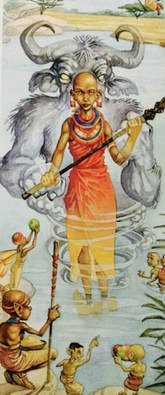|
"Nya-Nya Bulembu or the Moss-Green Princess" is a tale from Swaziland. I first found this story summarized in the picture book Finding Fairies: Secrets for Attracting Little People From Around the World. The story was intriguing, and I tracked down the original version in the 1908 book Fairy Tales from South Africa.
In the 1908 version, there is a Chief with two wives and a daughter by each one. He loves one daughter, Mapindane, and despises the other, Kitila. Wanting to humiliate Kitila, the chief has his hunters go out seeking a monster called the Nya-nya Bulembu, a hideous beast with a moss green hide. He sends his huntsmen to find such a creature. They find one living in a blue pool, but when they summon it with a chant, it turns out to be old and toothless with no moss on its hide. The second is equally unimpressive. Finally, they find a suitably terrifying beast in a green pool. They bring it home and skin it. When Kitila is wrapped in the skin, she cannot remove it and becomes indistinguishable from a normal Bulembu. She is left to live as a servant, abhorred by everyone for her monstrous appearance. However, one day she meets a fairy man who takes pity on her and gives her a carved stick. From then on, whenever she goes to bathe in the river, she is joined by the fairies, her monstrous skin comes off, and she becomes beautiful again for a little while. One day, a visiting prince sees her bathing and is stricken by her beauty. Even though she becomes hideous again when she leaves the water, he takes her as his wife. When she goes to bathe on the morning of their wedding, her Bulembu skin is finally stripped off once and for all. The couple lives happily ever after. The book is verrry dated. Although the foreword says that the tales are traditional, I was unsure whether I would find other versions of it. It turns out that Nyanyabulembu (plural dinyanyabulembu) is a Setswana word which translates as dragon. I also found the story "A Boy Goes After a Nyanyabulembu," performed by Sarah Dlamini, in the book The Uncoiling Python: South African Storyteller and Resistance. In this story, a king wants a Nyanyabulembu skin to make a coat for his child - not as a curse, but as a sign that this child is beloved and will one day be the next king. Only one boy is brave enough to go hunting the monster. Just like the huntsmen in the first story, he visits two blue pools, where he summons the monster with a short chant, but finds it unimpressive. At a third, green pool, he finds a strong, healthy monster. It chases him, and at the end of the chase the monster is killed, the boy is greatly rewarded, and the monster's skin is turned into a ceremonial cloak for the next king. In some places, there are parallels - most notably, the repetition of finding the monster in its pool and trying to find one suitably frightening. However, the intent of the hunt and the creation of the Nyanyabulembu cloak is completely different. One story is reminiscent of Cinderella and Beauty and the Beast. The other is the tale of a young man coming of age. EDIT 7/2/2018: I've found another version of the story! "The Ogre Scaly-Heart" (Nwambilutimhokora) features a beautiful young bride who, en route to her wedding, is forced to switch places with an ogre and wear a hideous monster skin. When she's alone, she takes off the skin and bathes in the river, and is joined by the ghosts of her relatives and servants. The truth is revealed when a child sees her and tells the intended husband. (The life of a South African tribe, vol 2, by Henri A. Junod.) And even more variants exist:
Sources
1 Comment
For a while, I've been looking into the story behind the film Kirikou and the Sorceress - a great cartoon, watch it if you ever have the chance. It begins with a tiny boy being born, already able to walk and talk. From there, he sets out to defeat the sorceress who's attacking his village.
I knew the story came from folklore, but all the source material is in French, so it was kind of difficult for me to figure anything out. When I started doing more research into the mytheme of the tiny hero, or thumbling, I came across the story of Fereyel and Debbo Engal the Witch, which has a very similar beginning and plot, although it takes a different path. It took me a while, but I finally came across one source that cited Fereyel as being from the Fula or Fulani people of the Gambia, a long thin country surrounding the Gambia river, right on the coast of West Africa. So today I went back to Kirikou and was watching the first few minutes. I was reading some of the critics' reviews and noticed that they said the original story was from West Africa. The director Michel Ocelot grew up in Guinea, and heard stories from the Fulani who lived nearby in Senegal. Senegal surrounds Gambia. Jackpot. A few search points and Google translates of French reviews later, I got to the researcher and writer Amadou Hampâté Bâ, who compiled folktales including the one that inspired Kirikou. It looks like Kirikou came from the story of Njeddo Dewal, mother of calamity, who was defeated by the child Bâgoumawe. I love finding stuff. Anyway, if you have 75 free minutes, check out Kirikou and the Sorceress. You can find it easily on YouTube. It's slow-paced, and occasionally somewhat surreal, but it's really good. |
About
Researching folktales and fairies, with a focus on common tale types. Archives
July 2024
Categories
All
|
Writing in Margins

 RSS Feed
RSS Feed
